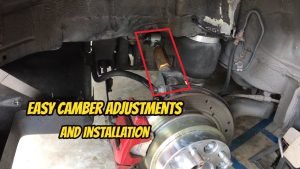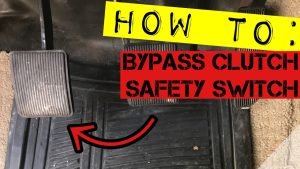To adjust the clutch engagement point, locate the clutch cable or hydraulic actuator and tighten or loosen it as needed for proper engagement. Now, let’s dive into the details.
When driving a manual transmission vehicle, the clutch is an essential component that allows you to shift gears smoothly. Over time, the clutch may need to be adjusted to ensure proper engagement. The engagement point is the moment at which the clutch starts to transmit power from the engine to the transmission.
If the engagement point is too high or too low, it can cause issues like difficulty in shifting gears or a slipping clutch. Fortunately, adjusting the clutch engagement point is a relatively simple task that can be done by tightening or loosening the clutch cable or hydraulic actuator as needed. By following a few steps, you can have your clutch adjusted and enjoy a smoother driving experience.
Contents
Understanding The Clutch Engagement Point
The clutch engagement point refers to the position at which the clutch pedal engages the clutch mechanism. It is crucial to adjust the clutch engagement point for optimal performance. By adjusting it, you can ensure a smooth transition between gears and prevent clutch slippage.
Incorrect adjustment of the clutch engagement point can lead to difficulties in shifting gears, grinding noises, and premature wear on the clutch. Adjusting the engagement point allows for proper clutch operation, reducing the risk of damage and improving overall driving experience.
To adjust the clutch engagement point, you will need to locate the adjustment mechanism, usually found near the clutch pedal or on the clutch cable. Follow the manufacturer’s instructions or consult a professional if you are unsure how to properly adjust it.
Keep in mind that the clutch engagement point may vary depending on factors such as driver preference and vehicle make and model. Regular maintenance and adjustment will ensure a longer lifespan for your clutch system.
Signs That Your Clutch Engagement Point Needs Adjustment
Adjusting the clutch engagement point is vital to ensure smooth gear shifting and prevent clutch slippage. One sign that your clutch engagement point needs adjustment is difficulty shifting gears. If you find it hard to shift gears, particularly when transitioning between lower and higher gears, it could be a sign that the engagement point needs tuning.
Another indication is clutch slippage, which occurs when the clutch fails to grip the flywheel properly, resulting in a loss of power. Lastly, grinding noises while shifting gears can also indicate an improper clutch engagement point. If you hear grinding noises when shifting, it means the clutch is not fully disengaging or engaging, causing friction and grinding of gears.
If you experience any of these signs, it is important to have your clutch engagement point adjusted by a professional mechanic. Maintaining a properly adjusted clutch engagement point ensures optimal performance and prolongs the lifespan of your clutch system.
Steps To Adjust The Clutch Engagement Point
To adjust the clutch engagement point, start by locating the clutch adjustment mechanism. Once found, identify the clutch engagement point. Next, loosen or tighten the clutch adjustment mechanism as necessary. After making the adjustment, test the clutch engagement point. If needed, repeat the adjustment process until the desired engagement point is achieved.
This will ensure that the clutch engages smoothly and at the desired position. Adjusting the clutch engagement point is crucial for optimal vehicle performance and smooth gear shifting. Follow these steps carefully to maintain a well-functioning clutch system.

Credit: www.miata.net
Tips For A Smooth Clutch Engagement Point
For a smooth clutch engagement point, it’s important to master proper clutch pedal technique. This involves gently releasing the clutch while applying gradual pressure on the gas pedal. Regular clutch maintenance is also crucial to ensure optimal performance. Regularly checking clutch fluid levels and inspecting for any signs of wear or damage can help prevent major issues.
Additionally, choosing the right clutch kit is essential. Consider factors such as driving style, vehicle weight, and power output to select a clutch kit that suits your needs. By following these tips, you can adjust the clutch engagement point and enjoy smoother shifting and improved driving experience.
Frequently Asked Questions On How To Adjust Clutch Engagement Point
Can You Adjust Clutch Bite Point?
Yes, you can adjust the clutch bite point.
Should A Clutch Biting Point Be High Or Low?
The clutch biting point should be low for better control and smoother gear shifting.
How Do You Adjust The Biting Point On A Hydraulic Clutch?
To adjust the biting point on a hydraulic clutch, locate the adjustment screw and turn it clockwise to increase or counterclockwise to decrease the biting point.
Why Is My Clutch Point So Low?
A low clutch point may be due to worn-out clutch linings or a clutch cable needing adjustment.
Conclusion
Adjusting the clutch engagement point is an important skill for any driver to have. By understanding how to properly adjust this point, you can improve your vehicle’s performance and extend the lifespan of your clutch. Whether you drive a manual or automatic, taking the time to make adjustments can result in smoother shifting and reduced wear on your clutch components.
Remember to start by locating the adjustment mechanism, whether it be a cable or hydraulic system. Then, follow the manufacturer’s instructions or consult a professional if needed. It’s crucial to make small adjustments and test the clutch engagement point before making any further changes.
With practice and patience, you’ll be able to achieve the perfect engagement point that suits your driving style, ensuring a more enjoyable and efficient driving experience. So, take the time to master clutch adjustment and enjoy the benefits it brings to your vehicle’s performance.
Affiliate Disclosure: As an Amazon Associate, I earn from qualifying purchases made through links on this site.









